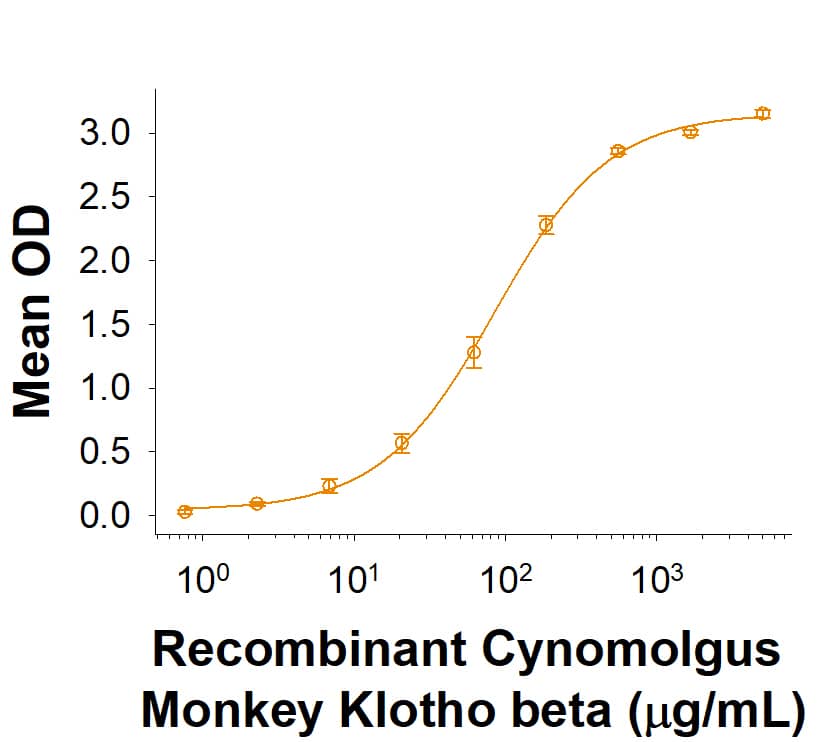Recombinant Cynomolgus Monkey Klotho beta His Protein, CF
R&D Systems, part of Bio-Techne | Catalog # 10428-KB

Key Product Details
Product Specifications
Source
Phe53-Leu997, with a C-terminal 6-His tag
Purity
Endotoxin Level
N-terminal Sequence Analysis
Predicted Molecular Mass
SDS-PAGE
Activity
When Recombinant Human FGF-21 (Catalog # 2539-FG) is immobilized at 1 µg/mL (100 µL/well), Recombinant Cynomolgus Monkey Klotho beta His-tag (Catalog # 10428-KB) binds with an ED50 of 0.05-0.4 μg/mL.
Scientific Data Images for Recombinant Cynomolgus Monkey Klotho beta His Protein, CF
Recombinant Cynomolgus Monkey Klotho beta His Protein Binding Activity
When Recombinant Human FGF-21 (Catalog # 2539-FG) is immobilized at 1 µg/mL (100 µL/well), Recombinant Cynomolgus Monkey Klotho beta His-tag (Catalog # 10428-KB) binds with an ED50 of 0.05-0.4 µg/mL.Recombinant Cynomolgus Monkey Klotho beta His Protein SDS-PAGE
2 μg/lane of Recombinant Cynomolgus Monkey Klotho beta His-tag (Catalog # 10428-KB) was resolved with SDS-PAGE under reducing (R) and non-reducing (NR) conditions and visualized by Coomassie® Blue staining, showing bands at 110-130 kDa.Formulation, Preparation and Storage
10428-KB
| Formulation | Supplied as a 0.2 μm filtered solution in PBS, Glycerol and EDTA. |
| Shipping | The product is shipped with dry ice or equivalent. Upon receipt, store it immediately at the temperature recommended below. |
| Stability & Storage | Use a manual defrost freezer and avoid repeated freeze-thaw cycles.
|
Background: Klotho beta
Klotho beta (KLB), a divergent structural member of the glycosidase I superfamily, is a type I transmembrane protein expressed primarily in the liver and pancreas, with lower expression in adipose tissue (1). Klotho beta, along with the closely related Klotho, consists of a large extracellular domain (ECD) containing two glycosidase-like regions, a transmembrane domain, and a short intracellular tail. The two glycosidase-like regions of Klotho beta share high homology to the one beta-glycosidase family yet lack the critical active site Glu residues present in beta-glycosidases necessary for catalytic activity, though physiologically relevant enzymatic activity for Klotho beta has been suggested (2, 3). The ECD of mature cynomologus Klotho beta shares 97% and 80% amino acid sequence identity with the ECD of human and mouse Klotho beta, respectively. Similar to Klotho, Klotho beta helps to regulate multiple metabolic processes in mammals by acting as a co-receptor that facilitates binding between FGF19 subfamily members and their receptors (4). The Klotho beta mediated interaction of FGF19 (FGF15 in mouse) with FGF Receptor 4 in the liver negatively regulates bile acid synthesis by controlling the secretion of two key bile acid synthase genes, cholesterol 7- alpha hydroxylase (Cyp7a1) and sterol 12- alpha hydroxylase (Cyp8b1) (5-7). Klotho beta is also a cofactor for the interaction of FGF21 with FGF Receptor 1c in adipocytes, which allows FGF21 to stimulate GLUT1 expression, up-regulating adipocyte insulin-dependent glucose uptake (5 - 8). Regulation of Klotho beta function has been suggested as a therapy for several cardiometabolic diseases (9).
References
- Mian, I.S. (1998) Blood Cells Mol. Dis. 24:83.
- Ito, S. et al. (2000) Mech Dev. 98:115
- Goetz, R. et al. (2007) Mol. Cell. Biol. 27:3417.
- Kuro-O, M. (2019) Nat Rev Nephrol. 15:27.
- Ito, S. et al. (2005) J. Clin. Invest. 115:2202.
- Kurosu, H. et al. (2007) J. Biol. Chem. 282:26687.
- Lin, B. C. et al. (2007) J. Biol. Chem. 282:27277.
- Ogawa, Y. et al. (2007) Proc. Natl. Acad. Sci USA 104:7432.
- Min, X. et al. (2018) J. Biol. Chem 293:14678.
Alternate Names
Gene Symbol
UniProt
Additional Klotho beta Products
Product Documents for Recombinant Cynomolgus Monkey Klotho beta His Protein, CF
Product Specific Notices for Recombinant Cynomolgus Monkey Klotho beta His Protein, CF
For research use only

